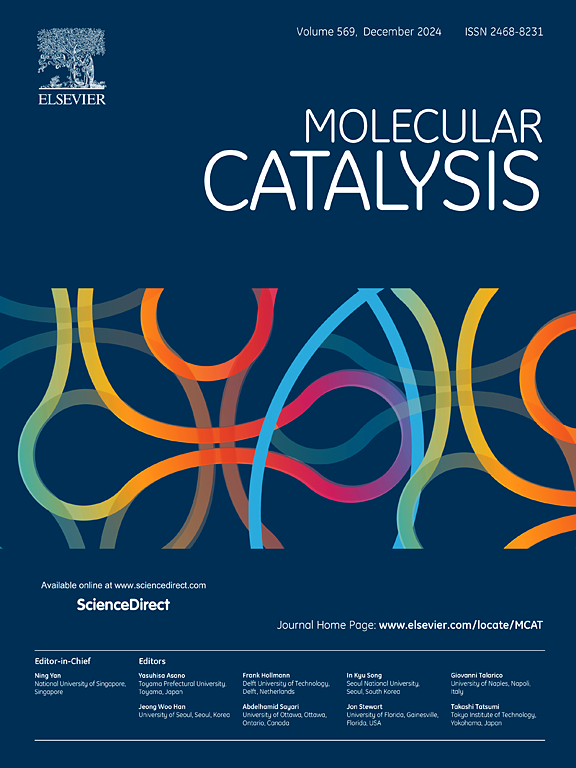fsp制备Ru/Ti-SiO2 CO2甲烷化催化剂的联合dft -实验研究
IF 3.9
2区 化学
Q2 CHEMISTRY, PHYSICAL
引用次数: 0
摘要
采用火焰喷雾热解法(FSP)一步合成ti改性SiO 2,作为CO 2甲烷化反应中ru基催化剂的载体。Ti的加入导致锐钛矿和金红石型tio2相的形成,增强了Ru/Ti- sio2催化剂的催化活性。对一步FSP技术制备的不同Ti浓度的Ru/Ti- sio₂催化剂进行基准测试表明,浸渍法制备的催化剂的催化活性明显高于FSP法制备的催化剂,漫反射红外傅立叶变换光谱(DRIFTS)揭示了两种技术之间不同的CH₄形成机制。对于fsp制备的催化剂,主要通过CO途径进行,而浸渍制备的催化剂则通过CO 2的解离吸附(CO途径)和表面甲酸酯的形成进行。为了解释Ti负载对Ru/SiO₂催化剂的影响,采用密度泛函理论(DFT)和微动力学模型相结合的多尺度分析方法研究了不同催化剂对CO₂的吸附行为。结果表明,高含量的Ti降低了CO₂在Ru/SiO₂催化剂上的吸附强度,表明CO₂与催化剂表面的相互作用发生了改变。本文章由计算机程序翻译,如有差异,请以英文原文为准。

A combined DFT-Experimental study on FSP-made Ru/Ti-SiO2 catalysts for CO2 methanation
Flame spray pyrolysis (FSP) was employed to synthesize Ti-modified SiO₂ in a single step, serving as the support for Ru-based catalysts in CO₂ methanation reactions. The addition of Ti led to the formation of anatase and rutile TiO₂ phases, enhancing the catalytic activity of Ru/Ti-SiO₂ catalysts. Benchmarking between Ru/Ti-SiO₂ catalysts of various Ti concentrations prepared using one-step FSP techniques indicated significantly higher catalytic activity for the impregnation-made catalysts compared to the FSP-made ones, where diffuse reflectance infrared Fourier transform spectroscopy (DRIFTS) revealed different CH₄ formation mechanisms between two techniques. For FSP-made catalysts, it predominantly occurred through the CO route, whereas the impregnation-made proceed via both the dissociative adsorption of CO₂ (CO route) and through surface formate species formation. To explain the effect of Ti loading on Ru/SiO₂ catalysts, a multiscale analysis combining density functional theory (DFT) and microkinetic modeling was performed to study the adsorption behavior of CO₂ on different catalysts. The results revealed that a high amount of Ti reduced the adsorption strength of CO₂ on Ru/SiO₂ catalysts, indicating a modified interaction between CO₂ and the catalyst surface.
求助全文
通过发布文献求助,成功后即可免费获取论文全文。
去求助
来源期刊

Molecular Catalysis
Chemical Engineering-Process Chemistry and Technology
CiteScore
6.90
自引率
10.90%
发文量
700
审稿时长
40 days
期刊介绍:
Molecular Catalysis publishes full papers that are original, rigorous, and scholarly contributions examining the molecular and atomic aspects of catalytic activation and reaction mechanisms. The fields covered are:
Heterogeneous catalysis including immobilized molecular catalysts
Homogeneous catalysis including organocatalysis, organometallic catalysis and biocatalysis
Photo- and electrochemistry
Theoretical aspects of catalysis analyzed by computational methods
 求助内容:
求助内容: 应助结果提醒方式:
应助结果提醒方式:


